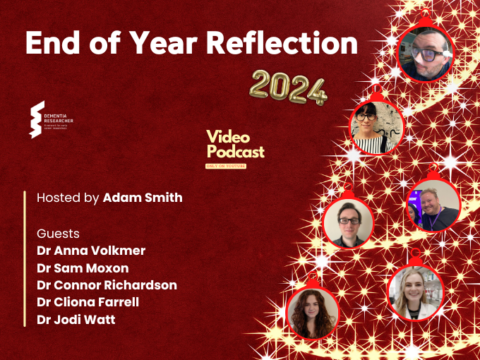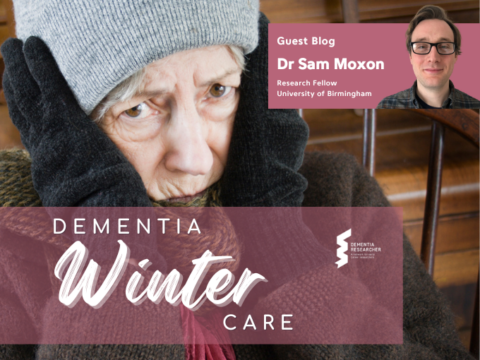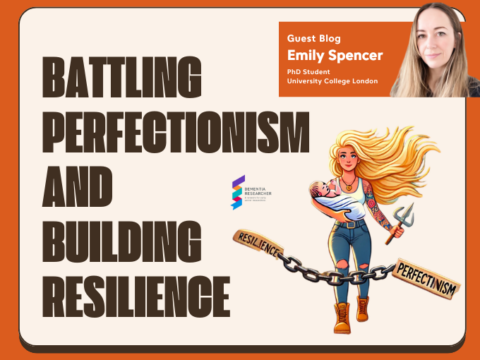Hi everyone! Welcome back to the second part of my introduction to the dementia researcher blog. In this blog I wanted to introduce myself as a researcher, with a tour of my research career so far.
Cancer Research
My first experiences were nothing to do with dementia, the first time I worked in a professional research lab was in cancer research on the effect of Poly (ADP-ribose) Polymerase (PARP) inhibitors on lung cancer cells. However, I quickly learned that I did not enjoy working in the lab, I found the environment much more stressful than my colleagues. This combined with an unsupportive supervisor almost put me off any kind of research career for good!
Bio-imaging / Immunology
My second experience of real research labs could not have been more different from the first. I had a brilliant supervisor Dr Xiao-Nong Wang and the project resulted in my first publication, using whole-mount immunofluorescence staining of human dermis to visualize the distribution of skin immune system components in 3 dimensions. The study found differences in immune components in healthy and inflamed skin, having implications for understanding the role micro anatomy plays in the rejection of skin grafts.
Cognitive Reserve in the Newcastle 85+ Study
After taking a break from science all together for a year, I came back to study for a master’s degree in public health and health services research. During this time, I was able to combine my interests in the biology of ageing and neuroscience with my interest in epidemiology and medical statistics. It was a huge learning curve, since my last qualification in maths was my GCSE. I worked with Blossom Stephan on the associations between cognitive reserve and cognitive function in the oldest-old using data from the Newcastle 85+ cohort, a cohort study of individuals living in Newcastle Upon Tyne who were all aged 85 at the time of recruitment.
For those who are not familiar with the theory of cognitive reserve, also often called cognitive resilience; it is the theory that a combination of socio-economic and behavioural factors can the slow cognitive decline in those with dementia pathology. We published a paper showing how in the oldest-old, higher reserve associated with better baseline global and domain-specific cognitive function and reduced risk of prevalent dementia, but not cognitive decline or incident dementia. Increasing reserve could promote cognitive function in the oldest-old.
Mild Cognitive Impairment (MCI)
I continued to work with Blossom on my PhD funded by the Alzheimer’s Society. This began my ongoing and most important research relationship with the Cognitive Function and Ageing Studies (CFAS), which is a set of two identical multi centre cohort studies which are fully representative of the UK population over the age of 65.
Using this study, I investigated the state of MCI in the UK population. My main finding from the work was that using additional measures of mild impairment that represent the full spectrum of cognitive decline that MCI prevalence remained stable in the UK population over 20 years, compared to dementia which decreased.
I have continued to work on research of MCI from a global health perspective. Recently we published papers showing that like in high income populations MCI is poorly defined in low- and middle-income countries which cause highly unstable prevalence estimates. We also produced analysis that prevalence of vascular related mild cognitive impairment has decreased in China, partially be explained by increased educational attainment across generations.
Neuropathology of Dementia
Since completing my PhD, I have worked with the CFAS Neuropathology, using brains donated by around 600 participants of the CFAS studies. As the statistician affiliated to the study I have been able to dip into a wide range of dementia pathology research showing Advanced Glycation End Product Formation in Human Cerebral Cortex Increases with Alzheimer-type neuropathology, that glial responses vary extensively across the ageing parietal white matter with diverse patterns of white matter neuro-inflammation, and the exciting finding that dementia in the older population is associated with neocortex content of serum amyloid P component.
Impacts on social connections and wellbeing of COVID-19 policies in the older population: CFAS cohort over 75s (OPPO)
Finally, I am working with the CFAS studies on a 10 year follow up wave of the study called OPPO. One project from this study is currently investigating new randomised control trial designs and the feasibility of delivering internet-based interventions for reduction of dementia risk. We are also using data collected over the course of the COVID-19 pandemic to investigate the longer-term impacts of the COVID-19 on older people and risk factors for dementia. In my most recent publication we showed that loneliness in older people increased by 8% over the course of the pandemic.
And that brings you up to date with my research career so far. I hope you have enjoyed this whistle stop tour!

Dr Connor Richardson
Author
Dr Connor Richardson is a Neuro-epidemiology Research Associate in the Newcastle University Population Health Sciences Institute. Connor is the research statistician for the Cognitive Function and Ageing studies (CFAS) multi-centre population cohort. His research interest lies in using advanced statistical modelling and machine learning to measure dementia risk. Connor blogs about his research, Equality, Diversity and Inclusion and sometimes his Pomapoo’s.

 Print This Post
Print This Post





